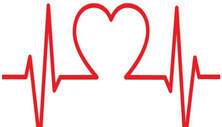SHOCKABLE VS. NON-SHOCKABLE HEART RHYTHMSMany of our students ask the question "What is the difference between a shockable and non-shockable heart rhythm?" A shockable versus nonshockable initial rhythm can be determined by a shock as opposed to a no-shock message from an automated external defibrillator (AED) or by a review of the electronic recording.
The four rhythms are divided into two groups: two that do not require defibrillation (called “nonshockable”) and two that do require defibrillation (“shockable”). The two nonshockable rhythms are pulseless electrical activity (PEA) and asystole and the two shockable rhythms are pulseless ventricular tachycardia and ventricular fibrilation. The ECG will distinguish asystole from ventricular fibrillation, ventricular tachycardia and pulseless electrical activity. The ECG appearance of ventricular asystole looks almost like a straight line with the occasional P-wave. Pulseless electrical activity (PEA) is the absence of a palpable pulse or other signs of circulation despite the presence on the ECG monitor of an observable QRS complex which normally produce a pulse. Ventricular fibrillation (v-fib) is a common cause of out-of-hospital cardiac arrests. In v-fib the heart begins to quivers with no blood being pumped out of the heart. On the monitor, v-fib will look like a irregular and disorganized wavy line. Ventricular fibrillation may be fine or coarse; coarse ventricular fibrillation is more likely to convert after defibrillation than fine v-fib. Pulseless ventricular tachycardia is a rhythm that is perfusing poorly with patients may or may not be displaying a pulse. Most patients with this rhythm are unconscious and pulseless and the use of the AED is necessary to “reset” the heart so that the primary pacemaker or the Sinoatrial Node can take over. With shockable heart rhythms, if the patient is being monitored, the rhythm can often be identified before significant deterioration.
Comments
|
AuthorDr. Tracy A. Jones is the CEO of Help-A-Heart CPR, LLC and an American Heart Association, ASHI, and American Red Cross Master Program Trainer, Instructor, & AHA Faculty Member located in San Antonio, Texas. Archives
June 2024
Categories |
Help-A-Heart CPR, LLC | 1747 Citadell Plaza Suite 101 | San Antonio, Texas 78209 | (210) 380-5344 | [email protected]
Copyright © Help-A-Heart CPR, LLC 2024
100% Certification Acceptance
We promise your employer, school, or agency will accept the certification card we issue to you. If there is a question of acceptance or validity, simply send us an email at [email protected] with full details. We will reach out to the individual/entity and provide accreditation information. If still there’s a question, we will provide you with a full refund of your class fee. It’s that simple.
We promise your employer, school, or agency will accept the certification card we issue to you. If there is a question of acceptance or validity, simply send us an email at [email protected] with full details. We will reach out to the individual/entity and provide accreditation information. If still there’s a question, we will provide you with a full refund of your class fee. It’s that simple.
|
Communities Served
ALABAMA: Birmingham
ARKANSAS: Fayetteville, Hot Springs, Jonesboro, Little Rock NEW MEXICO: Albuquerque TENNESSEE: Knoxville TEXAS: Amarillo, Arlington, Austin, Bandera, Bastrop, Boerne, Brownsville, Comfort, Converse, Corpus Christi, Dallas/Ft. Worth, Del Rio, Dripping Springs, El Paso, Floresville, Fredericksburg, Georgetown, Harlingen, Houston, Junction, Katy, Kerrville, Kingsville, Kingwood, Laredo, Lubbock, Lufkin, McAllen, Midland, New Braunfels, Odessa, Pleasanton, Round Rock, San Angelo, San Marcos, Schertz, Seguin, Taylor, Temple, Texarkana, Tyler, Universal City, Victoria, Waco, The Woodlands |
Why Choose Help-A-Heart CPR?
1. Flexible Scheduling
2. On and Off Location Training Available 3. Casual, Fun Atmosphere 4. Best Price Guarantee 5. All Instructors are AHA and/or ARC certified 6. 5 Star Google Reviews 7. Blended Learning (Online & Skills Check) Available 8. Meets OSHA & College CPR Requirements 9. Get Certified Within 3-4 Hours 10.Certification Is Good For Two Years 11. Official AHA/ARC/ASHI Training Site 12. High Quality Safety Training! |








